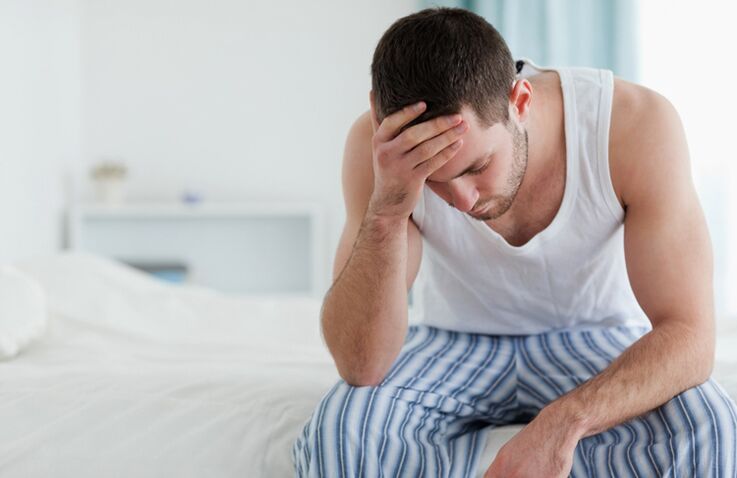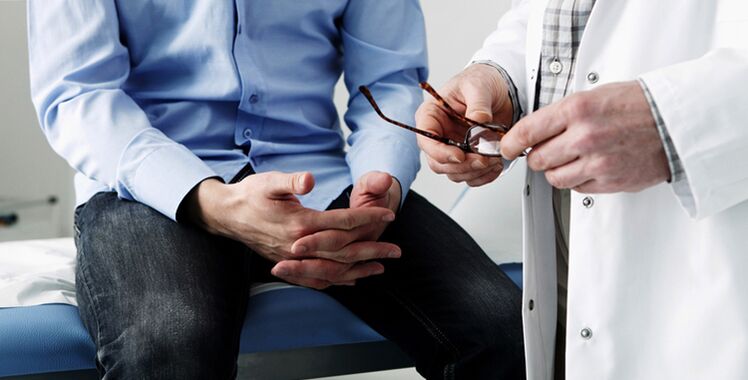The prostate is a gland in the male body. The normal parameters of a healthy organ are 2. 5-4. 5 cm long and 3-4 cm wide. It consists of glands and muscle tissue and forms at age 23, when the accumulation of hormones increases. The gland or secretory tissue produces a special fluid (secret) that is released during ejaculation and is a component of semen.
The secret of the prostate has an alkaline response and provides vital motility and mobility of sperm, protecting them from the acidic environment of the vagina.
what is prostatitis
This is an inflammation of the prostate that exists only in men and is associated with the production of male sex hormones. Ligaments connect the glands to the pubic junction between the bones, the base of which converges with the bladder and surrounds the initial portion of the urethra.
The prostate is located in the small pelvis and is separated from the rectum by a thin connective tissue septum. This anatomical location of the prostate explains the problems that arise when it becomes inflamed and enlarged. The glands press on the urethra, causing poor urine flow.
Compression of the rectum can lead to constipation. A location close to the perineum can cause pain in the area.
Assign acute and chronic prostatitis.
acute prostatitisCan be caused by a variety of bacteria:
- Escherichia coli.
- Staphylococcus aureus.
- Enterococcus.
- Pseudomonas aeruginosa.
- Enterobacteriaceae.
The presence of these pathogens in healthy humans is natural and harmless. But with reduced immunity, bacteria are activated, penetrate into the glandular tissue and cause an acute inflammatory process, manifested as:
- Elevated systemic and rectal (rectal) temperature. Also, rectal temperatures are usually higher than in the axillary area.
- Complaints of chills, fever.
- Pain in the groin, scrotum, and anus.
- Frequent painful urination (cramping, burning). Urging becomes more frequent at night.
- General poisoning. Weakness, muscle and joint pain, headache.
- Urine color changes. It becomes cloudy and sometimes mixed with blood.
- excreted from the urethra.

Caused by a slow or late acute course lasting more than 3 monthschronic form.It is characterized by:
- Genital area pain.
- Violation of urination.
- sexual disorder.
main reason
- urinary tract infection. For a long time, they may go unnoticed. The normal flora of the genitourinary system responds to the pathogenic flora for a period of time. But due to hypothermia or any other unfavorable condition, the invasive microbiota begins to flourish and inflammation begins.
- Prostate congestionis an important risk factor. Sedentary lifestyle, hemorrhoids, constipation - these factors lead to stagnant blood. The renewed oxygenated arterial blood actually stops flowing into the pelvic organs. Intracellular respiration decreases and infection becomes a sovereign mistress.
- irregular sex life, - when periods of increased sexual activity are replaced by prolonged abstinence. Frequent ejaculation and its limitations lead to stress and secretion dysfunction. Together with the aforementioned reasons, this provides the prerequisites for initiating the inflammatory process.
- obesity. Metabolic disorders leading to atherosclerosis and cholesterol deposition.
- low temperatureMay lead to decreased immunity.
- Alcohol and Tobacco AbuseNarrowing of the large blood vessels that supply the prostate.
- lack of physical activityThe muscles of the prostate are not allowed to function, and the secret is completely thrown out.
The first signs of prostatitis in men
- Weak urine flow and short range.
- Difficulty urinating, pain.
- intermittent flow.
- Prolonged urination.
- Incomplete bladder emptying.
- Frequent night calls.
symptoms and signs
Symptoms have two stages: latent (hidden) and active. During the incubation period, which can last several years, there are few complaints. Mild discomfort in the scrotum, anus, or glans.
Men try to ignore it or see it as overworked. Over time, the pain increases and it becomes more difficult to empty the bladder. This indicates that the latent period turns into an active period, inflammation begins to develop, and clear signs of disease appear:
- An unpleasant feeling during bowel movements.
- Filamentous discharge from the urethra during bowel movements.
- Perineal and urethral burns.
- Perceived issues with potency.
- Quick ejaculation.
- The bladder is partially empty and difficult.
- problems of a psychological nature.
- Repeated urination and pain associated with filamentous discharge.
- The erection process becomes long.
diagnosis
- medical record collection. The doctor will find out all complaints made by the patient. Time when symptoms first appeared. the presence of other diseases. Find out details about sexual activity, the presence of a permanent partner, and other information needed for an accurate diagnosis.
- Rectal Prostate Exam. Before the exam, give the patient a mini-enema to clean the bowel. Palpation allows you to identify increases and pain in organs. Thanks to prostate massage, part of the secret was released and handed over to laboratory research. The results allow you to determine the gland's microflora and the susceptibility of pathogenic microorganisms to drugs.
- Ultrasound. This test determines the size, density and structure of the prostate. For a more detailed examination, use a transrectal ultrasound. The tip of the device is inserted into the rectum, allowing part of the bowel and seminiferous ducts to be examined.
- cystoscopy. The procedure is performed using an endoscope. A thin probe with a camera is inserted into the urethra so that the bladder and glands can be viewed on the screen. Depending on the indication, they can perform a biopsy (tissue sampling for analysis).

Laboratory studies were also performed:
- General blood test (increased number of white blood cells).
- Urinalysis (presence of white blood cells, red blood cells, and protein in the sample).
- Bakposev pairs of microbial communities taken from the urethra (determination of susceptibility to antibiotics).
- Sperm analysis (motility, activity and accumulation of sperm, reproductive function status).
Methods and programs for the treatment of prostatitis
Treatment is complicated. Includes preparation for different directions and movements, as well as massage, physiotherapy and therapeutic exercises.
prescription:
- Broad-spectrum antibiotics (affect pathogenic flora).
- Alpha-blockers normalize urine output, improve blood filling of the pelvic organs, and reduce pain.
- Muscle relaxant.
Treatment also includes:
- Prostate massage (helps remove fluid retention and swelling). Acute infectious prostatitis is a contraindication to this procedure.
- Physiotherapy (electrophoresis, electrical stimulation, magnetic therapy and laser therapy).
- physiotherapy.
After these tests, only a doctor can prescribe medication!
prevention
- To prevent prostatitis, a mobile lifestyle is recommended. Walking, running, swimming, tennis are all good for health. Strength exercises and cycling should be limited.
- diet. Eat foods rich in vitamins and minerals. Do not abuse alcohol and nicotine, and limit consumption of pickles and bacon.
- Choose your partner carefully and avoid sexually transmitted infections.
- regular sex life.
Following these simple precautions will keep you healthy for years.























